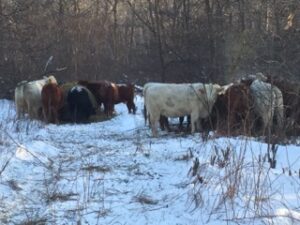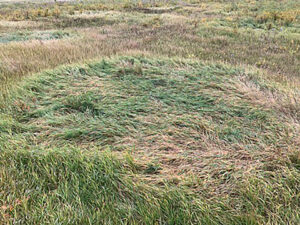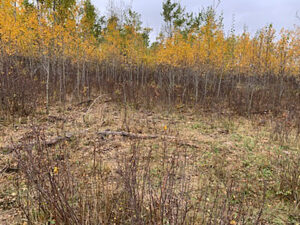Beat Costs and Boost Yields with Bale Grazing 🎙️
Editor’s note: The following is part one of a two-part series to help evaluate different considerations for bale grazing across Canada. Click here to read part two.
CLICK THE PLAY BUTTON TO LISTEN TO THIS EPISODE:
Listen to more episodes on BeefResearch.ca, Spotify, Apple Podcasts, Amazon Music or Podbean.
Many Canadian producers have taken steps to extend their grazing period and provide forage for cattle outside of confinement and away from corrals. Well planned extensive wintering systems have obvious benefits for reducing on-farm labour and yardage costs, but extended grazing also has environmental advantages for nutrient management and potential forage yield improvements.

Different methods of extended winter grazing may include annual forages for swath grazing, corn grazing, and grazing crop residue or cereals. Perennial forages can also be stockpiled for later grazing.
Bale grazing is another method of extensive wintering that is proving popular with farmers. Cattle graze bales on pastures and hay fields, typically through controlled access by electric fence. Bales can be purchased or grown on-farm and placed strategically in cells or “bale pods.” In some cases, cattle feed on bales directly where they are dropped from the baler but in most situations, bales are placed on pre-selected sites that need additional fertility or are located adjacent to stock water or natural or man-made shelter.
Producers typically set bales on their round sides, 35 to 40 feet apart, and remove twine or netwrap prior to allowing cattle access to the area. Some farmers try to source bales that are wrapped in sisal twine, which breaks down over time making follow-up twine management easy.
When producers place bales, they are importing nutrients onto a site not just from the forage itself but also from the urine and manure of grazing cattle. This reduces manure handling and hauling costs and also allows farmers to target areas in need of soil improvements. Any residual forage left ungrazed after cattle have moved to the next area isn’t a waste, but rather a source of nutrients for subsequent forage crops, litter to help increase water holding capacity and water infiltration of the soil, and a forage species seedbank.
The number of days producers choose to allow their cattle access to a pod of bales will depend on how many bales are placed, quality of the feed, body condition score of the cattle, weather, and the farmer’s personal goals and management style. Some producers will move cattle every two to five days, while other producers will allow cattle access for 20 or 30 days of feed at a time, or even longer.

It’s important to feed test and weigh bales placed in grazing areas to ensure cattle have a relatively level plane of nutrition and avoid a “rumen roller coaster” caused by too much or too little feed. Producers may use hay, greenfeed, or even straw with supplementation, however feed testing is the key to ensuring a balanced ration is achieved and potential toxicity issues are avoided.
Bale grazing can improve perennial pastures and even be used to reduce brush encroachment; however, it is not suited for all sites. Avoid placing bales on environmentally sensitive sites such as wetlands or creeks. Do not bale graze on native rangeland to prevent introduction of invasive or weedy species that can upset the balance of natural biodiversity or reduce the overall ecological integrity of a site.

Monitor snow conditions closely. Snow should not be used as the sole water source for lactating cows, freshly weaned calves, or cattle with a body condition score of 2.5 or lower. A dwindling snow pack can cause animals’ stock water demands to spike, even when other water is available. Excess snow can cause cattle to expend extra energy to access feed, something that should be avoided for cattle groups that require higher levels of management such as calves, young cows, or thin cattle.
It’s always important to have a back-up plan with any extensive wintering system and bale grazing is no different. A prolonged harsh winter can increase the need for additional shelter and better-quality forage or supplementation for animals in any condition. Producers must manage and closely monitor cattle to ensure they stay healthy, remain in good body condition, and have access to forage that is of adequate quality, as well as access to water and shelter.
Producers are finding forage management success and cost savings by trying new methods of extensive wintering, but like any beef cattle production practice, bale grazing requires planning and management. Stay tuned for part two in the series that covers producer experiences and top tips for bale grazing from different regions across Canada.
Learn more:
- Body Condition (BCRC web page)
- Extended Grazing (BCRC web page)
- Feed Testing & Analysis for Beef Cattle (BCRC Decision Tool & web page)
- Hooves not Harrows – Harnessing Cow Power to Rejuvenate Forages (BCRC blog post)
- Three Tips for Swath and Bale Grazing (BCRC blog post)
Click here to subscribe to the BCRC Blog and receive email notifications when new content is posted.
The sharing or reprinting of BCRC Blog articles is welcome and encouraged. Please provide acknowledgement to the Beef Cattle Research Council, list the website address, www.BeefResearch.ca, and let us know you chose to share the article by emailing us at [email protected].
We welcome your questions, comments and suggestions. Contact us directly or generate public discussion by posting your thoughts below.